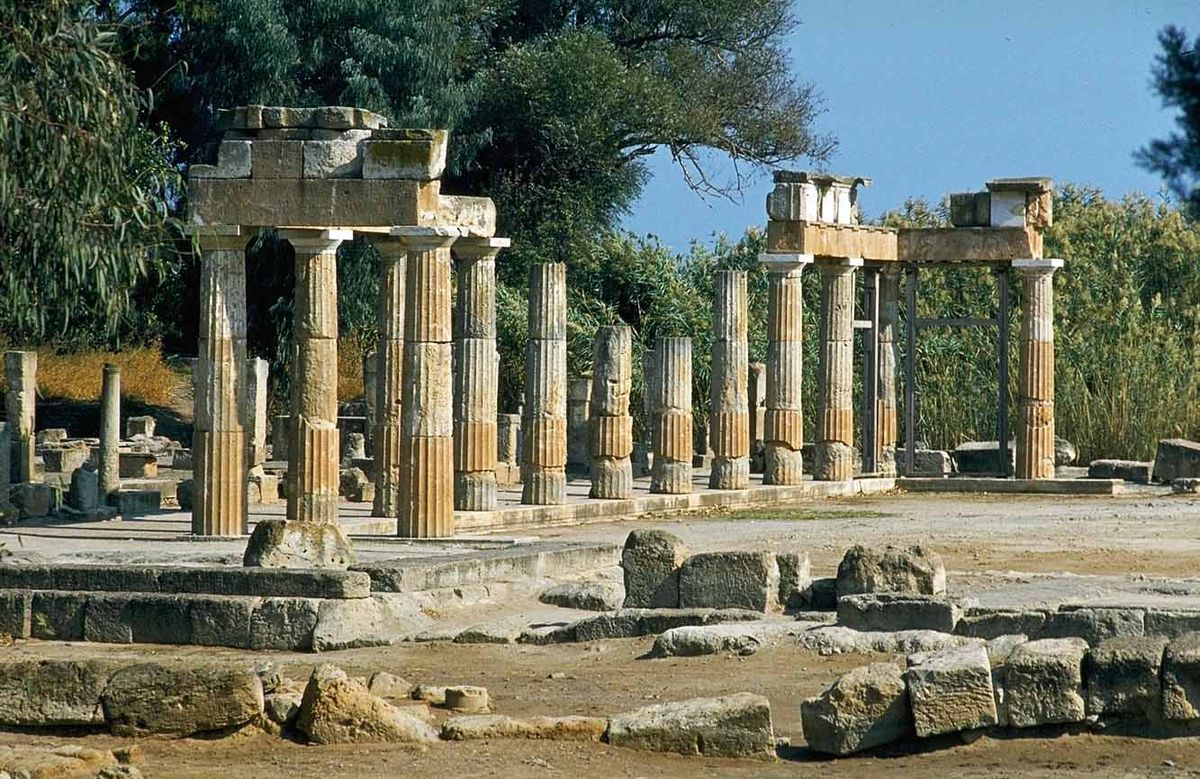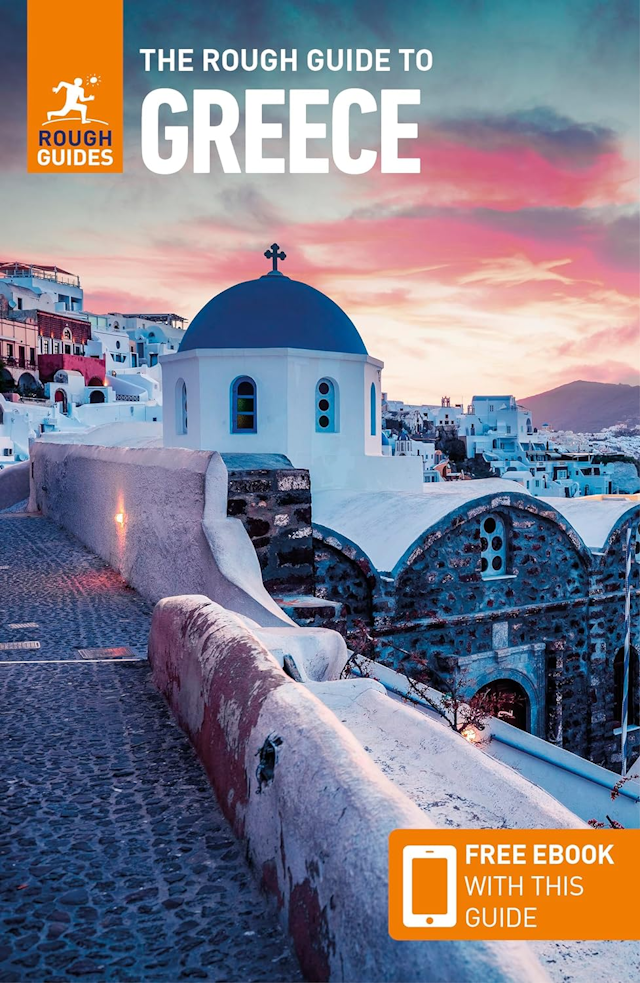Vravrona
(or Brauron)
The archaeological site of Vravrona or Brauron is in Attica near Athens Airport and has the Sanctuary of Artemis, the Sacred House, and an excellent little Archaeological Museum.
Unusually, the ancient site of Vravrona is located at the foot of a hill rather than on top of one, as many sites are. On the crown of the small hill here is a pretty little Byzantine chapel dedicated to St George: Agios Giorgios.

The village and site are in a valley surrounded by agricultural land, an attractive area with abundant wildlife. The people are welcoming as they aren't over-run with visitors and they appreciate anyone who makes the effort to visit the site.
The Story of Vravrona
The story of Vravrona is a fascinating one. Its main focus is the mysterious Sanctuary of Artemis, of which only the foundations remain today. Artemis is the Greek equivalent of the Roman goddess Diana, is the daughter of Zeus, and the twin sister of Apollo. She was the moon goddess as well as the goddess of childbirth, the harvest, hunting, and wildlife.
Every four years a festival would take place at Vravrona in which young girls would dress as bears and dance. Aristophanes refers to the dance in his play Lysistrata, but like the one that centered on the site at Eleusis, to the west of Athens, we don't know exactly what took place at Vravrona or why.
Iphigenia
In his play Iphigenia at Tauris, Euripides relates events at Vravrona. Iphigenia, the daughter of Agamemnon and Clytemnestra, was held responsible for a strong wind that prevented the Greek ships from sailing to Troy, prior to the Trojan War. The wind was sent in retribution for the killing of one of the wild animals that Artemis protected, probably a bear. Agamemnon agreed to the sacrifice of his daughter on the altar of Artemis at Vravrona so that the ships could set sail.
According to Euripedes, the goddess spared Iphigenia because she would not allow her altar to be stained by human blood, and substituted a deer for the sacrifice instead. Iphigenia went on to found the sanctuary here, dedicated to Artemis.
In other versions of the story Iphigenia was indeed sacrificed. Her alleged grave was discovered here, south of the stoa (a colonnaded building) and next to the remains of the Sacred House, where the priestess of the Artemis cult stayed during the festivals.
Excavating Vravrona
By the 4th century BC, the area here had flooded and the communities that had arisen all disappeared. The village of Vravrona eventually reestablished itself, but it was not until 1946 that work began on uncovering the site of ancient Vravrona, work that continued until 1963. It revealed the remains of a 5th-century BC temple and, next to it, a stoa that may be even older. Inscriptions describe it as 'the Parthenon of the Bears'.
Beside the stoa are the remains of one of the oldest stone bridges you will see anywhere in the world. The structure dates back to the 5th century BC. Other evidence from the site points to the existence here of stables, a gymnasium, and other buildings, but these have not yet been roperly uncovered.
Archaeological Museum
The Archaeological Museum is a few minutes' drive south of the site, towards Porto Rafti. It displays finds from the site and elsewhere, and is intriguing despite its comparatively small size. It includes a scale model of the temple that gives a vivid impression of how the site would have looked in its prime. It's worth finding the time to visit the museum.
Among the more important exhibits is a decorated stirrup jar from about 1200-1000 BC that was found in the late-Mycenaean cemetery at Perati, a 5-minute drive south of Vravrona. Also notable is a beautifully-detailed statue that has been dated to the fourth century BC, depicting a young girl holding a rabbit. Several other statues and busts date from the same period, and there is a fascinating collection of pottery and jewellery.
A votive relief of Artemis, from Vravrona itself, also dates from the 4th century BC. It shows the goddess seated and welcoming pilgrims of all ages.
Getting to Vravrona
There is a bus service which stops outside the ancient site, if anyone wants to visit. It comes from Loutsa, which is about 5.5 miles (9 kms) north of Vravrona, so you could also walk if the bus times aren't convenient. There are buses to Loutsa from Athens, and the journey takes about 90 minutes.
The easiest way to get to Vravrona is obviously by rental car, and the journey from central Athens should take about 45 minutes.
Alternatively, you could rent a car at Athens airport, from where it's only a 20-minute drive to Vravrona. It's even close enough to take a taxi, if you can negotiate a fixed price with the driver to take you to the site and to the museum, and return you to the airport.
Latest Posts
-
Study: Athens Among Best Cities for Family Science Trips
Athens is ranked as one of the top European cities for family science trips, according to a report by Ubuy, a global e-commerce platform. Ubuy’s new report reveals Europe’s top 20 cities where familie… -
May 1: Greece Labor Day Strikes to Halt Public Transport, Ferries
Transportation and travel in Greece will be disrupted on Wednesday, May 1, as public transport and ferry employees have announced their participation in strike mobilizations to mark May Day. According… -
Technopolis: New 3-day Beer Festival Coming to Athens in May
A new beer festival is coming to Athens and for three days will quench the thirst of beer lovers with well-known and rare labels from around the world as well as from Greek microbreweries. Lager? Pils… -
5 Reasons to Spend Easter in Meteora
Renowned for its spectacular “hanging” monasteries and reverent atmosphere, Meteora is the perfect place to spend Greek Easter. -
3 Must-Visit Islands for Greek Easter
Boasting spectacular landscapes and unique local traditions, the islands of Lesvos, Ikaria and Andros are ideal vacation destinations for Greek Easter. -
Easter Cookies from Smyrna, a 100-Year-Old Recipe
Discover the secret to making the most delicious Easter koulourakia (cookies) from Smyrna, passed down through five generations. -
Greece Launches Contactless ‘Tap & Pay’ System on Athens Airport Express Buses
The Greek Transport Ministry on Wednesday launched a pilot ‘Tap & Pay’ contactless payment system for passengers traveling on the express bus lines in Athens that connect to Athens International Airpo… -
Acropolis Museum Exhibition: The Parthenon and Byron
On the occasion of 200 years since Lord Byron’s death, the Acropolis Museum in Athens is honoring his memory with a symbolic exhibition related to Lord Elgin’s taking of the Parthenon sculptures. -
Greece Bans Sunbeds, Umbrellas, Bars on 198 Beaches
Sunbeds, umbrellas, and all sorts of constructions have been banned on 198 beaches across Greece according to a joint ministerial decision signed this week by Economy & Finance Minister Kostis Hatzida… -
4 Guesthouses in Zagori that Are Worth Visiting
Amidst the mountains and spectacular scenery, these four traditional guesthouses in the heart of Zagori, Epirus, offer the very best in Greek hospitality.











